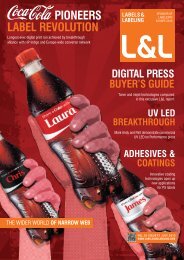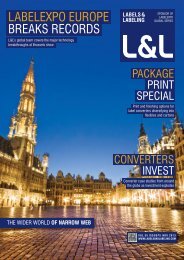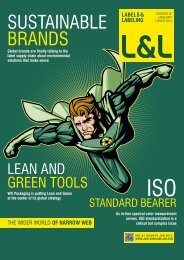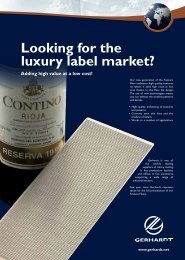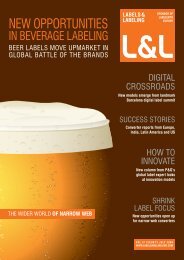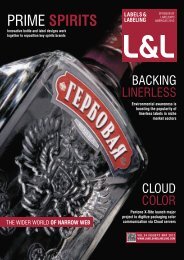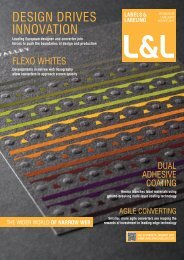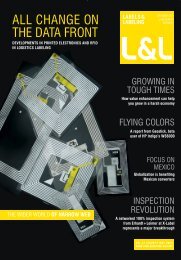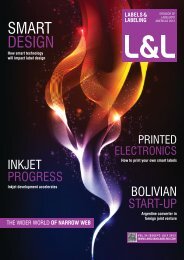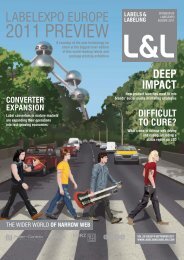SELL
Download - Labels & Labeling
Download - Labels & Labeling
- No tags were found...
You also want an ePaper? Increase the reach of your titles
YUMPU automatically turns print PDFs into web optimized ePapers that Google loves.
78 | L&L<br />
QUICK FACTS<br />
l Mike Fairley predicts that by next year<br />
one quarter of all new roll label presses<br />
installed worldwide will be digital, rising to<br />
40 percent by 2020. The current figure is<br />
15 percent.<br />
l 57 percent of conventional jobs are under<br />
25,000m run length and 71 percent under<br />
50,000m. 65 percent of digital full color<br />
jobs are under 10,000m and 95 percent<br />
full color under 50,000m.<br />
THE event closed with a panel session with all the speakers<br />
l Inkjet growth forecast is 30 percent from<br />
2010 to 2014.<br />
in a liquid, simulating offset inks. The<br />
‘one-shot’ print process, where colors are<br />
built up on the blanket before transferring<br />
the complete image to the substrate,<br />
provides perfect register, said Lakin. ‘It<br />
can produce the same look and feel as<br />
conventional offset and has the ability to<br />
print seven colors. Customers can mix<br />
their own spot colors onsite.’<br />
In terms of new ink developments, HP<br />
Indigo recently launched an invisible red<br />
ink, now being used on a WS4000-series<br />
machine in the Indian pharmaceutical<br />
market to help fight counterfeiting.<br />
Although it has the technology, Lakin<br />
explained HP has not used inkjet heads<br />
for its label presses because they can’t<br />
(yet) produce high enough quality. ‘And<br />
inkjet is a classic example of a print<br />
process that must be pristine to ensure it<br />
prints well.’<br />
Domino’s Vlad Sljapic headed the<br />
argument for inkjet; ‘its reliability,<br />
simple design and construction brings<br />
scalability. Inkjet can be made wider<br />
and faster, has application versatility<br />
in and off-line, prints color and black<br />
and white and spot varnish and digital<br />
foiling.’ The non-contact system makes<br />
it possible to print on heat sensitive,<br />
textured and pre die cut materials,<br />
said Sljapic. ‘The number of colors<br />
is unrelated to speed and there is no<br />
practical imposition limit, so waste and<br />
cost can be minimized, especially on<br />
low ink coverage jobs.’<br />
Sljapic sought to clear up some<br />
‘misperceptions’ around inkjet. ‘Although<br />
inkjet can print on uncoated surfaces,<br />
coated substrates are recommended for<br />
the best print quality.’<br />
Adrian Steele, Mercian Labels, said<br />
inkjet is restricted by a ‘lack of confidence’<br />
in the industry. ‘It is still a niche market<br />
and the user needs technology to cover all<br />
markets to make it worth their while.’<br />
Soren Ringbo, who manages Nilpeter’s<br />
digital press operations, believes a<br />
combination of UV inkjet and conventional<br />
print is the future: ‘Inkjet is simpler than<br />
the electrophotographic process, and<br />
scaleable. In addition, non-contact printing<br />
means the thickness of the substrate is<br />
LABELS&LABELING<br />
not so critical and it is possible to print<br />
on rough surfaces.’ Neil Holiday, UPM<br />
Raflatac discussed material selection<br />
for each digital printing process. ‘What’s<br />
needed is the same range of label stock,<br />
good ink transfer and adhesion between<br />
ink and substrate.’<br />
FINISHING<br />
Whether digital print should be finished<br />
on- or off-line has been an ongoing<br />
discussion. Delegates heard that some<br />
78 percent of current digital installations<br />
have off-line systems. Finishing systems<br />
are overwhelmingly used for die cutting,<br />
and 78 percent varnish inline. Some key<br />
vendors, however, believe the future is<br />
in-line converting. Vlad Sljapic of Domino,<br />
for example, told delegates finishing<br />
in-line is a growing trend. Sljapic also<br />
believes that digital varnishing with inkjet<br />
has a good future.<br />
ABG’s Mike Burton said in-line finishing<br />
reduces labor costs and has higher<br />
productivity, whereas off-line finishing can<br />
be maximized where multiple decorating<br />
processes are required. At Labelexpo the<br />
company showed both in-line and off-line<br />
variants of its Omega Digicon 2 digital<br />
label converters with semi-automatic<br />
turret rewinds.<br />
Burton said laser technology has<br />
advanced rapidly, offering a non-stop<br />
finishing line with no downtime. Although<br />
laser has limitations with some substrates,<br />
it can cut most papers, and PET and PP<br />
if laminated/varnished. When questioned<br />
about the high cost, Burton explained;<br />
‘You need to consider how much is spent<br />
a year on dies; in terms of time, money,<br />
logistics, transport and operator error. It<br />
can be used as a sales tool to win new<br />
business.’ A low cost ‘entry level’ system<br />
will be launched at Drupa using one<br />
rather than two lasers.<br />
MIS<br />
Andrew Mckerlie of LabelTraxx explained<br />
that a good MIS system is critical for an<br />
efficient digital label printing operation.<br />
‘Can your MIS cope with three times the<br />
number of current orders? Because that<br />
is what happens with digital.’<br />
His colleague Katie Nightingale gave a<br />
live demonstration of the system; showing<br />
how the customer logs in online, receives<br />
a quote through E-traxx, can choose<br />
tooling, laminate, main stock, finish, even<br />
labels per roll and can upload artwork.<br />
LabelTraxx accesses all this information<br />
to process the job and send to the<br />
automated prepress system.<br />
Later, in the panel session chaired by<br />
Mike Fairley, a popular topic for discussion<br />
was the willingness of customers to adapt<br />
to online ordering, for which they have to<br />
take responsibility for the quality of digital<br />
artwork.<br />
CONVERTER EXPERIENCE<br />
Trevor Smith from Amberley Labels<br />
told delegates about his company’s<br />
experience with digital printing since<br />
installing the UK’s first HP Indigo press,<br />
a WS4000, back in 2002-3. ‘The brand<br />
owner gets differentiation, order flexibility<br />
and a high quality digital solution with<br />
specific color matches, metallic material<br />
and cost effective proofing. The result is<br />
a consistent, high quality brand image,<br />
ability to order to requirement, increased<br />
sales and new customers.’<br />
For Amberley Labels the future<br />
challenges include business automation,<br />
multi-layer requirements, finding cost<br />
effective ultra short runs and continuing to<br />
sell on added value, not price. In addition,<br />
Smith said, ‘there is a wider range of<br />
competing technologies. We are now<br />
competing in a digital environment instead<br />
of a conventional one.’<br />
Xeikon press user Adrian Steele from<br />
Mercian Labels said digital print has<br />
rapidly become commoditized. ‘Make<br />
sure you’re prepared to invest four years<br />
and find niche markets as it is a very<br />
competitive world.’ Steele noted that<br />
variable data has yet to emerge as a<br />
significant application, and ‘same day<br />
delivery’ is also something of a myth. The<br />
company delivers 90 percent of jobs in five<br />
days. Looking at materials useage, Steele<br />
reported just over half is paper, 37 percent<br />
white PP and 12 percent clear. ‘Digital is a<br />
new culture, its requires annualized hours<br />
and there is wastage.’ Steele advised.



